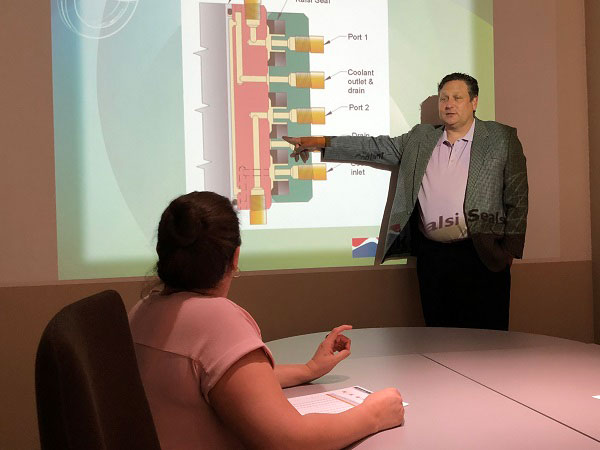Hydraulic Swivel Design Course

Since several types of Kalsi-brand rotary shaft seals provide excellent high-pressure performance when used as hydraulic swivel seals, we offer a training course on hydraulic swivel design. This course is offered to existing and potential seal customers at no cost. We can provide this training at your location or ours, or by web conferencing. Contact us for additional information, or to schedule training.
Overview of Our Company and the Hydraulic Seals We Offer
At the beginning of the class we give a brief introduction to Kalsi Engineering and the operating principle of our rotary shaft seals, for the benefit of attendees who may not be familiar with Kalsi Engineering or our products. This is followed by a discussion of the types of rotary seal designs that have utility in hydraulic swivels, and the implications their features and operating characteristics have on the layout of a coaxial or side entry swivel.
Mandrel Design
The training includes a mandrel-related discussion of running surface and installation path considerations. The running surface portion of the discussion covers tolerances, surface finish, and surface hardening for wear resistance. The installation path portion of the discussion covers the design of the installation chamfer and how to address mandrel features that could cut the swivel seals during installation, such as radial hydraulic ports, threads, keyways, etc. The use of installation tools to prevent Kalsi Seal damage is also discussed in this section.
Housing Design
A housing design-related discussion focuses primarily on the annular grooves that locate the swivel seals. The key topics include groove dimensions, groove wall surface finishes, mandrel-to-housing extrusion gap clearance, sharpness of the extrusion gap corners, and installation of seals into the grooves. Initial filling of the swivel is also discussed, to ensure that the bearing oil seals and swivel seals are exposed to a lubricating fluid during rotary operation. Venting strategies are also discussed, to prevent thermal expansion-related pressure buildup of the bearing lubricant, and to address another potential pressure buildup issue associated with some swivel designs.
If relevant to the customer’s hydraulic pressure objective, the potential use of laterally floating backup rings is included in the training. Separate training that focuses on the design of floating backup rings is available to backup ring licensees.
Avoiding Bearing-Related Pitfalls
A bearing related discussion covers several topics relevant to hydraulic swivel design, including how to avoid differential thermal expansion-related binding, and the design of locating shoulders for ease of disassembly.
A Discussion of Potential Heat Transfer Strategies
A heat transfer discussion includes a description of why seal-generated heat concentrates in the seal track portion of the mandrel, why heat generation increases with speed, and how elevated temperature impacts high pressure seal performance and life. A discussion of strategies for optional cooling circulation is also included, so these strategies are understood when difficult applications are encountered.
Summary of Training Objectives
The training is intended to provide mechanical engineers and designers with an understanding of the types of swivel seals we manufacture, and how to implement them in coaxial and side entry hydraulic swivels. It is also intended to provide an introduction to relevant sections of our rotary seal handbook so they can be referenced during swivel design activities.
For a list of other rotary seal-related training classes, click here.
